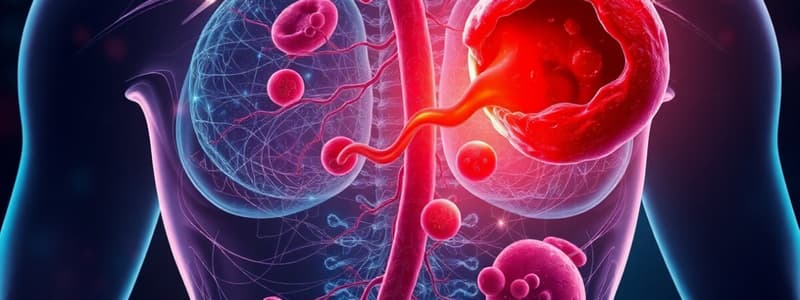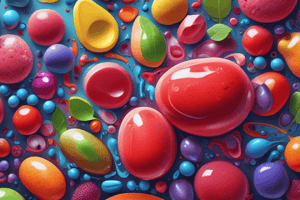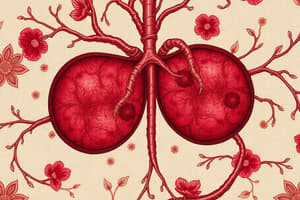Podcast
Questions and Answers
What percentage of blood is composed of plasma?
What percentage of blood is composed of plasma?
- 70%
- 55% (correct)
- 45%
- 30%
Which type of white blood cell is most responsible for killing bacteria and pathogens?
Which type of white blood cell is most responsible for killing bacteria and pathogens?
- Basophils
- Eosinophils
- Lymphocytes
- Neutrophils (correct)
What role do platelets play in the body?
What role do platelets play in the body?
- Transport oxygen
- Produce hormones
- Stop bleeding (correct)
- Fight infections
Which component of plasma makes up the highest percentage?
Which component of plasma makes up the highest percentage?
What process describes the development of blood cells?
What process describes the development of blood cells?
What is the primary function of lymphocytes?
What is the primary function of lymphocytes?
Which formed element is primarily responsible for phagocytosis of pathogens?
Which formed element is primarily responsible for phagocytosis of pathogens?
Which statement about erythrocytes is true?
Which statement about erythrocytes is true?
What is the primary consequence of hemolysis in the bloodstream?
What is the primary consequence of hemolysis in the bloodstream?
What is the primary function of eosinophils in the immune response?
What is the primary function of eosinophils in the immune response?
What is the primary role of hemoglobin in erythrocytes?
What is the primary role of hemoglobin in erythrocytes?
Which type of white blood cells primarily increases the overall inflammatory response?
Which type of white blood cells primarily increases the overall inflammatory response?
What percentage of total white blood cells do neutrophils comprise?
What percentage of total white blood cells do neutrophils comprise?
What structural feature do erythrocytes possess that aids in their function?
What structural feature do erythrocytes possess that aids in their function?
Polycythemia is primarily characterized by which condition?
Polycythemia is primarily characterized by which condition?
Which of the following is a component of hemoglobin?
Which of the following is a component of hemoglobin?
What percentage of oxygen is carried by hemoglobin in the blood?
What percentage of oxygen is carried by hemoglobin in the blood?
Which characteristic is NOT typical of neutrophils?
Which characteristic is NOT typical of neutrophils?
What distinguishes agranulocytes from granulocytes?
What distinguishes agranulocytes from granulocytes?
What condition is characterized by a decreased oxygen-carrying capacity of the blood?
What condition is characterized by a decreased oxygen-carrying capacity of the blood?
In which type of anemia is there insufficient red blood cell production due to poor bone marrow function?
In which type of anemia is there insufficient red blood cell production due to poor bone marrow function?
Which of the following conditions can lead to hemolysis?
Which of the following conditions can lead to hemolysis?
Which ion is essential for the function of the haem portion of hemoglobin?
Which ion is essential for the function of the haem portion of hemoglobin?
Which statement about the binding of carbon dioxide with hemoglobin is true?
Which statement about the binding of carbon dioxide with hemoglobin is true?
What is the diameter range of monocytes?
What is the diameter range of monocytes?
In blood group A, what type of antibodies are present in the serum?
In blood group A, what type of antibodies are present in the serum?
Which blood group is known as the universal donor?
Which blood group is known as the universal donor?
What happens during the hemagglutination reaction?
What happens during the hemagglutination reaction?
What percentage of humans are Rh positive?
What percentage of humans are Rh positive?
What is the characteristic of blood group AB?
What is the characteristic of blood group AB?
In which organ are macrophages primarily formed from monocytes?
In which organ are macrophages primarily formed from monocytes?
What is the primary role of vitamin K in the blood clotting process?
What is the primary role of vitamin K in the blood clotting process?
What condition is characterized by a low platelet count and can lead to bleeding into skin and internal organs?
What condition is characterized by a low platelet count and can lead to bleeding into skin and internal organs?
Which cells are responsible for producing platelets under the influence of thrombopoietin?
Which cells are responsible for producing platelets under the influence of thrombopoietin?
Which symptom is commonly associated with hemophilia?
Which symptom is commonly associated with hemophilia?
What happens to the blood clot after it forms?
What happens to the blood clot after it forms?
What is the normal range of platelets per microliter of blood?
What is the normal range of platelets per microliter of blood?
What is a potential complication of thrombocytopenia related to the brain?
What is a potential complication of thrombocytopenia related to the brain?
What is typically observed in the urine of individuals with hemophilia?
What is typically observed in the urine of individuals with hemophilia?
What happens when an Rh negative person receives Rh positive blood for the first time?
What happens when an Rh negative person receives Rh positive blood for the first time?
Which of the following processes is involved in the prevention of blood loss?
Which of the following processes is involved in the prevention of blood loss?
What is the role of thrombin in blood coagulation?
What is the role of thrombin in blood coagulation?
In the case of Hemolytic Disease of the Newborn, what prevents damage to the first fetus?
In the case of Hemolytic Disease of the Newborn, what prevents damage to the first fetus?
Which factor initiates the conversion of prothrombin to thrombin in blood coagulation?
Which factor initiates the conversion of prothrombin to thrombin in blood coagulation?
What occurs during the second pregnancy of an Rh negative mother with an Rh positive fetus?
What occurs during the second pregnancy of an Rh negative mother with an Rh positive fetus?
What type of pathway is the intrinsic pathway associated with in blood coagulation?
What type of pathway is the intrinsic pathway associated with in blood coagulation?
What is primarily responsible for forming a platelet plug during hemostasis?
What is primarily responsible for forming a platelet plug during hemostasis?
Flashcards
Blood Composition
Blood Composition
Blood is 55% plasma and 45% formed elements.
Plasma Components
Plasma Components
Albumin, globulin, fibrinogen, and other components make up plasma.
Formed Elements
Formed Elements
Red blood cells, white blood cells, and platelets are formed elements.
Erythrocytes (RBC)
Erythrocytes (RBC)
Signup and view all the flashcards
Hemopoiesis
Hemopoiesis
Signup and view all the flashcards
Leukocytes (WBC)
Leukocytes (WBC)
Signup and view all the flashcards
Blood Function: Transport
Blood Function: Transport
Signup and view all the flashcards
Hemoglobin
Hemoglobin
Signup and view all the flashcards
Hemoglobin structure
Hemoglobin structure
Signup and view all the flashcards
Hemoglobin's role in oxygen transport
Hemoglobin's role in oxygen transport
Signup and view all the flashcards
Hemoglobin's role in CO2 Transport
Hemoglobin's role in CO2 Transport
Signup and view all the flashcards
Normal Hemoglobin levels (adult male)
Normal Hemoglobin levels (adult male)
Signup and view all the flashcards
Anemia
Anemia
Signup and view all the flashcards
Sickle cell anemia
Sickle cell anemia
Signup and view all the flashcards
RBC Function
RBC Function
Signup and view all the flashcards
Role of Hemoglobin(Hb) in blood group
Role of Hemoglobin(Hb) in blood group
Signup and view all the flashcards
Hemolysis
Hemolysis
Signup and view all the flashcards
Polycythemia
Polycythemia
Signup and view all the flashcards
Granulocytes
Granulocytes
Signup and view all the flashcards
Neutrophils
Neutrophils
Signup and view all the flashcards
Eosinophils
Eosinophils
Signup and view all the flashcards
Basophils
Basophils
Signup and view all the flashcards
Agranulocytes
Agranulocytes
Signup and view all the flashcards
Lymphocyte Function
Lymphocyte Function
Signup and view all the flashcards
Monocyte Function
Monocyte Function
Signup and view all the flashcards
Blood Transfusion
Blood Transfusion
Signup and view all the flashcards
Donor
Donor
Signup and view all the flashcards
Recipient
Recipient
Signup and view all the flashcards
Blood Group Factors
Blood Group Factors
Signup and view all the flashcards
Universal Recipient
Universal Recipient
Signup and view all the flashcards
Universal Donor
Universal Donor
Signup and view all the flashcards
Rh incompatibility
Rh incompatibility
Signup and view all the flashcards
Erythroblastosis fetalis
Erythroblastosis fetalis
Signup and view all the flashcards
First Rh-positive pregnancy
First Rh-positive pregnancy
Signup and view all the flashcards
Second Rh-positive pregnancy
Second Rh-positive pregnancy
Signup and view all the flashcards
Hemolytic jaundice
Hemolytic jaundice
Signup and view all the flashcards
Vascular Spasm
Vascular Spasm
Signup and view all the flashcards
Platelet Plug
Platelet Plug
Signup and view all the flashcards
Blood Coagulation
Blood Coagulation
Signup and view all the flashcards
Extrinsic Pathway
Extrinsic Pathway
Signup and view all the flashcards
Vitamin K's Role
Vitamin K's Role
Signup and view all the flashcards
What's a Blood Clot?
What's a Blood Clot?
Signup and view all the flashcards
Thrombocytopenia
Thrombocytopenia
Signup and view all the flashcards
Major Causes of Thrombocytopenia
Major Causes of Thrombocytopenia
Signup and view all the flashcards
Hemophilia
Hemophilia
Signup and view all the flashcards
Factor VIII and Hemophilia
Factor VIII and Hemophilia
Signup and view all the flashcards
Hemophilia Symptoms
Hemophilia Symptoms
Signup and view all the flashcards
Study Notes
Blood Composition
- Blood is a specialized connective tissue.
- It circulates within a closed system of blood vessels.
- It consists of formed elements suspended in a pale yellow fluid called plasma.
- Total blood volume is approximately 8% of total body weight.
- Body temperature is around 38°C.
- Blood pH is about 7.4, slightly alkaline.
Blood Functions
- Transports oxygen from lungs to tissues and carbon dioxide from tissues to lungs.
- Transports metabolic waste products to organs for excretion (lungs, kidneys, skin, intestines).
- Carries absorbed nutrients to the liver and other tissues.
- Regulates water balance.
- Regulates body temperature.
- Transports hormones, vitamins, and salts.
- Transports metabolites.
- Provides protection against infection through white blood cells (WBCs) and antibodies.
- Helps maintain normal acid-base balance.
- Plays a role in blood clotting through internal factors.
Blood Plasma
- Composed of 90-92% water.
- Includes dissolved organic and inorganic components, as well as some plasma proteins.
- Normal plasma volume is about 7-8% of total body weight.
- Plasma proteins (albumin and globulin) act as buffers and bind with lipids, hormones, vitamins, and minerals.
- Fibrinogens are crucial for blood clotting.
- Immunoglobulins are protective molecules (antibodies).
- Dissolved salts and inorganic components include Na, K, Mg, Ca, Cl, and phosphate.
- Nutrients include glucose, carbohydrates, amino acids, lipids, cholesterol, and vitamins.
- Waste components include urea, creatinine, uric acid, and bilirubin.
Formed Elements
-
Erythrocytes (RBCs):
- Formed from proerythroblasts, derived from hematopoietic stem cells.
- Contain hemoglobin.
- Biconcave disc shape.
- Diameter of 7-8 mm, thickness of about 2 mm.
- Lack a nucleus.
- Carry oxygen.
-
Leukocytes (WBCs):
- Nucleated, non-hemoglobin-containing cells.
- Derived from hematopoietic stem cells in red bone marrow.
- Normal count: 4000-10000 cells/mm³.
- Granulocytes (75% of total WBCs):
- Contain cytoplasmic granules; classified by staining properties.
- Neutrophils: Most common type; move toward infection sites to phagocytose microorganisms, effective against parasites.
- Eosinophils: Phagocytose antigen-antibody complexes, effective against parasites.
- Basophils: Convert into mass cells at infection sites; release histamine, serotonin, and heparin to attract other WBCs to infection sites.
- Agranulocytes (25% of total WBCs):
- Lack easily visible cytoplasmic granules.
- Lymphocytes: Involved in antibody formation (B lymphocytes) and cellular immunity (T lymphocytes).
- Monocytes: Convert into macrophages; highly phagocytic.
-
Thrombocytes (Platelets):
- Non-nucleated cells derived from megakaryocytes.
- Formed in bone marrow from megakaryoblasts.
- Fragments enclosed in a plasma membrane.
- Normal value: 150,000-400,000/μL of blood.
- Crucial for blood clotting.
Hemopoiesis (Haematopoiesis)
- Process of blood cell development.
- RBCs, WBCs, and platelets are formed in bone marrow.
- Active marrow: red bone marrow; inactive marrow: white bone marrow.
- Derived from hematopoietic stem cells.
Blood Groups and Transfusion
- Blood group determined by antigens on RBC surface.
- ABO system classifies blood into A, B, AB, and O types.
- Blood group A: Antigen A present; anti-B antibodies in serum.
- Blood group B: Antigen B present; anti-A antibodies in serum.
- Blood group AB: Antigen A and B present; no antibodies in serum (universal recipient).
- Blood group O: No antigens present; anti-A and anti-B antibodies in serum (universal donor).
- Rh factor (Rhesus blood group system):
- Antigen on RBCs; 85% of humans are Rh+.
- Rh- individuals can develop anti-Rh antibodies if exposed to Rh+ blood.
- Can cause serious complications in subsequent pregnancies involving a Rh+ fetus.
Blood Disorders
- Anemia: Reduced oxygen-carrying capacity of blood due to RBC deficiency.
- Aplastic anemia: Bone marrow dysfunction, insufficient RBCs.
- Blood loss anemia: Rapid hemorrhage.
- Megaloblastic anemia: Vitamin B12 or folate deficiency.
- Hemolytic anemia: Defects in hemoglobin or RBCs' membrane/ enzymes.
- Iron deficiency anemia: Insufficient iron absorption or excessive loss.
- Sickle cell anemia: Genetic mutation causing abnormal hemoglobin; RBCs take on a sickle shape, leading to organ damage.
- Haemolysis: Breakdown of erythrocytes, with the release of hemoglobin into the plasma.
- Polycythemia: Increased RBC concentration in blood (due to increased RBC production).
Blood Clotting (Hemostasis)
- Homeostatic processes prevent blood loss.
- Mechanisms include:
- Vascular spasm: Immediate vessel constriction following injury.
- Platelet plug formation: Platelets adhere to exposed collagen, aggregate, and form a plug.
- Blood coagulation: Plasma proteins form a fibrin clot.
- Clotting factors:
- Series of 12 proteins involved in the cascade reaction.
- Extrinsic and Intrinsic pathways: Two main pathways for prothrombinase formation.
- Conversion of prothrombin to thrombin, and soluble fibrinogen to insoluble fibrin threads.
- Clot formation: Blood cells, platelets, and plasma get trapped in fibrin threads.
- Serum: Extracted fluid after clot contraction.
Platelets (Thrombocytes)
- Differentiation from hematopoietic stem cells.
- Megakaryoblasts → Megakaryocytes → Platelet fragments.
- Crucial for blood clotting.
- Normal value: 150,000-400,000 /µL of blood.
Thrombocytopenia
- Decreased platelet count, leading to bleeding issues (in the skin and internal organs).
- Possible causes include bone marrow failure or excessive platelet destruction.
- Easy bruising, rashes, and bleeding in the nose and gums are common symptoms
Hemophilia
- Inherited clotting factor deficiency.
- Primarily affects males.
- Common symptoms include easy or prolonged bleeding following minor injury, internal bleeding.
- Deficiency of clotting factor VIII is a typical feature..
Studying That Suits You
Use AI to generate personalized quizzes and flashcards to suit your learning preferences.




